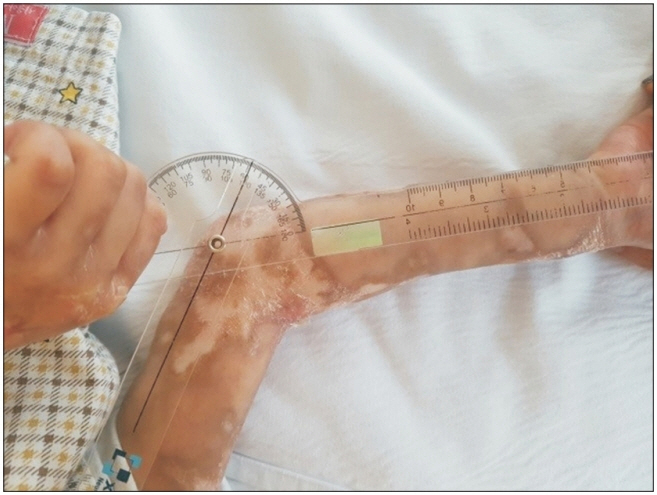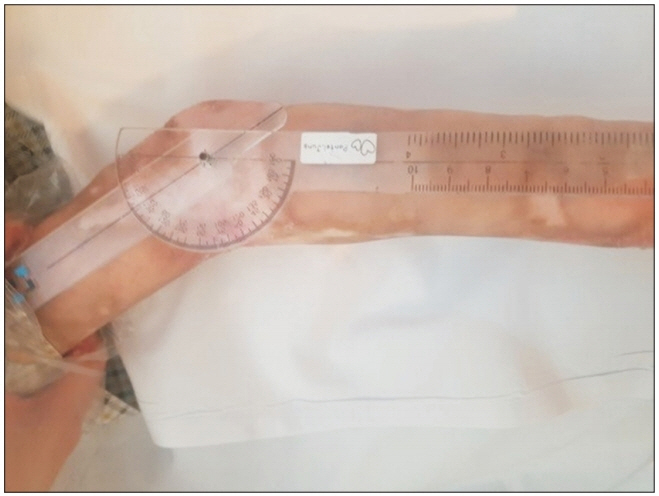Ann Rehabil Med.
2019 Jun;43(3):347-351. 10.5535/arm.2019.43.3.347.
Rehabilitation in Children With Sclerodermoid Chronic Graft-Versus-Host Disease: Case Series
- Affiliations
-
- 1Department of Rehabilitation Medicine, Asan Medical Center, University of Ulsan College of Medicine, Seoul, Korea. iysung56@gmail.com
- KMID: 2453926
- DOI: http://doi.org/10.5535/arm.2019.43.3.347
Abstract
- Joint contracture in chronic graft-versus-host disease (cGVHD) is refractory to treatment, and tends to deteriorate gradually over time. There is scant clinical research focusing on timing and intensity of rehabilitation on joint contractures in children with sclerodermoid cGVHD after hematopoietic stem cell transplantation. We retrospectively reviewed rehabilitative therapeutic effects in 6 children with sclerodermoid cGVHD, whose clinical records documented their condition, before and after rehabilitation therapies. Three children who started treatment within a mean of 2 months after the onset of joint symptoms, and who underwent home-based exercise twice daily for 30 minutes showed more prominent improvement in range of motion compared with the other 3 children, who started rehabilitation therapy later than 6 months after onset of joint symptoms, without regular home-based exercise.
MeSH Terms
Figure
Reference
-
1. Nanda A, Husain MA, Al-Herz W, Almekaimi A, Al-Sabah H, Al-Otaibi M. Chronic cutaneous graft-versus-host disease in children: a report of 14 patients from a tertiary care pediatric dermatology clinic. Pediatr Dermatol. 2018; 35:343–53.
Article2. Lee SJ, Flowers ME. Recognizing and managing chronic graft-versus-host disease. Hematology Am Soc Hematol Educ Program. 2008; 2008:134–41.
Article3. Thien M, Phan TG, Gardam S, Amesbury M, Basten A, Mackay F, et al. Excess BAFF rescues self-reactive B cells from peripheral deletion and allows them to enter forbidden follicular and marginal zone niches. Immunity. 2004; 20:785–98.
Article4. Marks C, Stadler M, Hausermann P, Wolff D, Buchholz S, Stary G, et al. German-Austrian-Swiss Consensus Conference on clinical practice in chronic graftversus-host disease (GVHD): guidance for supportive therapy of chronic cutaneous and musculoskeletal GVHD. Br J Dermatol. 2011; 165:18–29.
Article5. Carenzio G, Gherardi P, Bardoni MT, Zecca M, Bonetti F, Locatelli F, et al. Rehabilitation of chronic graft versus host disease in children: a clinical series. Eura Medicophys. 2007; 43:445–50.6. Mohammed J, Savani BN, El-Jawahri A, Vanderklish J, Cheville AL, Hashmi SK. Is there any role for physical therapy in chronic GvHD? Bone Marrow Transplant. 2018; 53:22–8.
Article7. Halar EM, Bell KR. Immobility and inactivity: physiological and functional changes prevention and treatment. In : DeLisa JA, Gans BM, Walsh NE, editors. Physical medicine and rehabilitation: principles and practice. Philadelphia: PanmLippincott Williams & Wilkinsuneducation;2004. p. 1447–67.8. Tendas A, Boschetto C, Baraldi L, Caiazza E, Cupelli L, Lentini R, et al. Homecare-based motor rehabilitation in musculoskeletal chronic graft versus host disease. Indian J Palliat Care. 2011; 17:159–61.
Article9. Deeg HJ. How I treat refractory acute GVHD. Blood. 2007; 109:4119–26.
Article10. Koreth J, Matsuoka K, Kim HT, McDonough SM, Bindra B, Alyea EP 3rd, et al. Interleukin-2 and regulatory T cells in graft-versus-host disease. N Engl J Med. 2011; 365:2055–66.
Article




